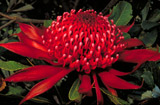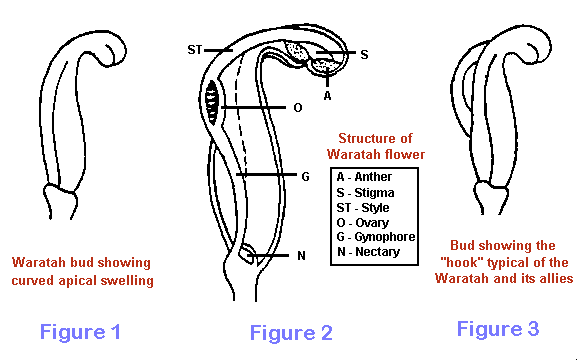|
[Front Page] [Features] [Departments] [SGAP Home Page] [Subscribe]

Australian Floral Emblems - Telopea speciosissima
Telopea speciosissima (the "Waratah") is the floral emblem of New South Wales and is one of Australia's best known and most spectacular native plants. It occurs in a semi-circle around Sydney extending from around Ulladulla in the south to Lake Macquarie in the north and west to the higher parts of the Blue Mountains. Until recently it was also regarded as occurring in the north of the state in the Gibraltar Range National Park west of Grafton, but this plant has now been described as a separate species (T.aspera).
The following article by Dr Jim Willis first appeared in 1959 in Volume 1 of the Society's journal "Australian Plants" and was reprinted, with some minor updating, in the March 1988 issue of the same journal. Dr Willis was Director of the Museum of Applied Arts and Sciences, Sydney, at the time the original article was written.
Apart from the recent separation of T.aspera, mentioned above, the article remains an excellent introduction to the genus Telopea and to the relationships between T.speciosissima and its related species. The description of the floral structure contains a number of terms which may be unfamiliar to the non-botanist. To assist in understanding the description, a glossary of terms is included at the end of the article.
The family Proteaceae is a very ancient, widespread family occurring in Australia, New Zealand, South Africa, South America and eastern Asia. It contains about 75 genera of which 44 are endemic to Australia.
Included in the plant family Proteaceae is Telopea, a small, endemic genus which contains four (now five...ed) species only, all of which are confined to the south-eastern regions of the continent and the island of Tasmania. The name Telopea is derived from the Greek "telepos", meaning "seen from afar" and refers to the conspicuous nature of the crimson heads of flowers which stand out from the dark green foliage in a striking fashion. The Aborigines called these beautiful shrubs "Waratah", and this is now the generally accepted vernacular name.
Of the four (now five...ed) species, Telopea speciosissima R.Br. (meaning "very handsome") is perhaps the most familiar. This species occurs in New South Wales from Gosford, Putty and the Blue Mountains, south to Conjola, and is found usually on sandstone. There is also an isolated occurrence in the Gibraltar Range east of Glen Innes (now T.aspera....ed). T.mongaensis Cheel (referring to the district of origin, Monga) is also a New South Wales species and occurs from Meryla State Forest near Moss Vale south to Mongarlowe valley. T.oreades F.Muell. (meaning "belonging to the mountains") occurs in the Bombala district and far south coast of New South Wales, extending into East Gippsland in Victoria. There is also an isolated population in the Mongarlowe Valley. T.truncata R.Br. (meaning "truncate" - referring to the truncate seed wing) is endemic to Tasmania, where it is widespread in the wet, mountainous regions.

The brilliant red flowers of Telopea speciosissima are eye-catching and make long-lasting cut flowers. Select the thumbnail image or plant name for a higher resolution image (33k).
Inflorescence
The flowers of all Telopea species are arranged in dense, terminal, racemose clusters (technically, the inflorescence in Telopea and all other Grevilleoideae is not a raceme but a conflorescence. As in all racemes, the flowers are borne on separate stalks, but they arise in pairs so close together on the rachis that they touch one another, and give the inflorescence the appearance of a head. The size and shape of the inflorescence varies with the species. For T.speciosissima the oldest flowers are at the base of the flower head, and the youngest ones are at the apex, and as a consequence the upper flowers are often still in bud when the lowest ones are fully opened. With the other three species, the apical flowers open first. In all species the inflorescence is surrounded at the base by an involucre of large bracts which vary in size according to the species.
Floral Structure
The individual flowers of Waratahs are small and are built up in parts of four. There is no separate calyx and corolla, instead, the flower parts consist of four perianth segments which, in the bud, appear to be fused together. This fusion, however, is not a true one, as the four segments can be separated by gently twisting the bud. This apparent union of the perianth segments is related to the pollination mechanism. Each perianth segment is somewhat strap-like in appearance with a hollowed out lobe at the apex, the four lobes forming an apical swelling which is curved towards one side (Figure 1). The flowers are consequently bilaterally symmetrical. Inside the swelling are four anthers on filaments that are fused to the tepal. Each of these sessile anthers, in the bud, is in close contact with the rather conical-shaped pollen presenter, which is placed laterally towards the end of the style (Figure 2). As the flower matures, the style grows faster than the perianth segments, and in order to make room for its increase in length, forces its way between the perianth segments, splitting them, and emerging in the shape of a hook, so typical of the Waratah flower and its allies (Figure 3).

The ovary, which is produced on the end of an elongated stalk known as the gynophore, is superior, and consists of one carpel containing a large number of ovules, whilst the nectary, which is located at the extreme base of the gynophore, is in the shape of an incomplete ring (Figure 2). The fruit formed from the ovary after fertilisation is a follicle of leathery texture up to 125mm long, containing many seeds which are quite flat and winged.
Description of Species
The following is a brief description of the species, which can readily be separated by the leaf and inflorescence characters:--
- 1. T. speciosissima ("Waratah").
- Stout, erect shrubs rarely above two metres in height, with alternate leaves 12-25 cm in length, sharply toothed in the upper part, from oblanceolate to obovate or almost cuneate, with prominent venation. Flowers in dense, ovoid or globular heads, 7-10 cm in diameter; involucral bracts crimson, ovate-lanceolate, the inner ones being 5-8 cm long. Fruit, a leathery follicle 8-10 cm in length.
- 2. T. oreades ("Gippsland Waratah").
- Gully and mountain shrubs, sometimes attaining tree height (up to 10 metres) with a stem diameter of 30-60 cm. Leaves alternate, 10-20 cm in length, usually entire from obovate to lanceolate, often glaucous on the under-surface, with mid-rib alone conspicuous. Flowers in ovoid or globular heads about 7 cm in diameter, with surrounding involucral bracts under 2 cm in length. Fruit, a leathery follicle 8-12 cm in length.
- 3. T. mongaensis ("Monga Waratah").
- Slender, branched shrubs to 2 metres in height, with alternate leaves 7-10 cm in length, narrowly lanceolate to oblanceolate, entire or with 2-3 sinuate lobes at the apex, slightly paler on the under-surface, conspicuously veined. Flowers in short, broad, rather flat heads about 7 cm in diameter; involucral bracts crimson, mucronate, sparsely fringed on the margins with rust-coloured hairs 1-4 cm long. Follicles 5-7 cm in length.
- 4. T. truncata ("Tasmanian Waratah").
- Erect or spreading shrubs to 2 metres in height, with alternate leaves 5-10 cm in length, from oblanceolate to obovate, entire, the margins often recurved, venation inconspicuous. Flowers in short, dense, flat heads about 5 cm in diameter; involucral bracts ovate, covered with appressed hairs, the inner (and longer) bracts being 2 cm long. Follicles 5-7 cm in length.
- 5. T. aspera ("Waratah"); This description has been added by the editor for completeness.
- Superficially similar to T.speciosissima and, until recently, was regarded as a northern form of that species. The differences between the two species are mainly in the foliage (the following is based on "The Flora of New South Wales" published by the Royal Botanic Gardens, Sydney):
- T.aspera - Adult leaves elliptical to obovate; margins with 3-11 pairs of teeth in the lower half; lowers surface moderately to densely covered with rusty hairs.
- T.speciosissima - Adult leaves narrow obovate to narrow spathulate; margins with 0-3 pairs of teeth in the lower half; lowers surface glabrous or moderately covered with rusty hairs.
Reproduced from the March 1988 issue of "Australian Plants"
Notes on botanical terms:
- Alternate (leaves) - leaves arranged so that one occurs on one side of a stem and the next occurs on the other (see also "opposite")
- Anther - the part of the stamen that produces the pollen
- Apical - at or towards the tip
- Appressed - closely pressed together
- Calyx - the outer ring of floral leaves, each of which is known as a sepal
- Corolla - the inner floral leaves, each of which is known as a petal
- Cuneate - wedge shaped
- Endemic - occurs only in a defined area and is not found outside of that area
- Entire - without serrations or lobes
- Filament - the stalk of the stamen (the anther is located at the end of the filament)
- Follicle - a dry, one celled fruit that splits along the inner edge
- Glabrous - without hairs
- Glaucous - having a whitish-grey lustre
- Gynophore - the stalk of a superior ovary
- Lanceolate - widening above the base and tapering to both ends
- Inflorescence - a group of flowers borne on one stem
- Involucre - a ring of bracts surrounding the base of a flower head
- Mucronate - terminating in a sharp, stiff point called a mucro
- Oblanceolate - roughly lanceolate but with the end nearest the stem being narrower than the distant end
- Obovate - roughly ovate but with the end nearest the stem being narrower than the distant end
- Opposite (leaves) - leaves arranged in pairs with each leaf occurring at the same distance along the stem but on different sides of the stem (see also "alternate")
- Ovate - egg shaped with the widest end attached to the stem
- Ovoid - egg shaped
- Perianth - the floral leaves (the petals and sepals collectively)
- Pollen Presenter - in Proteaceae, the uppermost part of of the style of a flower on which pollen becomes placed before the flower opens and which is subsequently "presented" to a pollinator
- Raceme - a cluster of flowers with the youngest at the apex
- Rachis - the axis of a compound inflorescence
- Recurved - curved backwards
- Sepal - see "Calyx"
- Sinuate - having a deep, wavy margin
- Spathulate - spoon shaped
- Stamen - the male part of the flower comprising the anther and filament
- Style - part of the pistil (the female part of the flower)
- Superior (ovary) - an ovary which is located above the level of the calyx
- Tepal - organ similar to a petal or sepal (in cases where the two are not clearly defined)
- Truncate - terminating abruptly as if cut off
- Venation - the pattern of the leaf veins
 [Front Page] [Features] [Departments] [SGAP Home Page] [Subscribe]
[Front Page] [Features] [Departments] [SGAP Home Page] [Subscribe]
Australian Plants online - March 1997
The Society for Growing Australian Plants
|